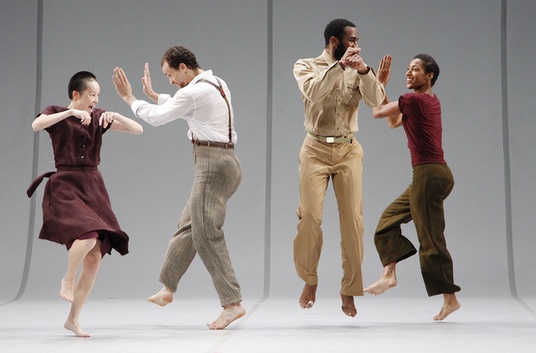Sun 10/9
We drove down to Akron to see the Bill T. Jones/Arnie Zane Company perform Analogy/Dora: Tramontane, a concert-length dance that tells of the experiences of a young Jewish girl during WWII.
The set was unusual. The E. J. Thomas Hall curtain was not only open; it was completely gone. The masking of the proscenium arch had been stripped away so that the lighting instruments were visible above and on either side of the stage. Six panels of dance linoleum covered the stage floor and rolled right up the back of the stage. The stage also held a little mic stand, a small low table and three panels lying flat. From where we were sitting, we could see into the pit where musicians Emily Manzo and Mike Hallett sat ready.
As Analogy/Dora: Tramontane begins, we hear a nursery rhyme in French. The nine dancers enter and whisk the bright red flats about to form a door, a window, a table. We gradually realize that most if not all of the continually surprising soundscape is being generated live by the musicians and dancers.
Dora Amelan’s story begins in 1939. She and her family are in Poland when the Germans invade. They flee to Antwerp but when the Germans invade Belgium Dora’s grandfather and some family members are dragged off and killed. Dora’s mother’s illness and travel restrictions force them to scatter. Dora eventually gets to Vichy France where she works for a children’s aid society and uses legal and illegal means to save as many people as possible from death in the concentration camps.
Jones and Amelan developed this memoir, this oral history, in an ongoing series of recorded interviews. What is surely an edited version of their dialogue is repeated by the dancers via handheld, wireless mics with the dancers frequently handing the mics off to each other. Dance materials sometimes resonate with the narrative.
Crucial words emerge from the dialogue. Did Dora’s efforts make her a “cooperator” or a “collaborator”? And how did Dora — or anyone — keep on in the midst of horror and privation? “Insouciance,” answers Dora, and as she explains her attitude, the dancer who gives voice to her words is carried by the rest of the dancers up, down, and upside down with nary a break in her voice.
In content, Analogy/Dora: Tramontane reminds us of other holocaust memoirs. Maus, Art Spiegelman’s graphic novel, and Diary of Anne Frank come to mind. But in form, Analogy/Dora: Tramontane reminds us of works by Dianne McIntyre which also used voice with dance in family histories such as Just Yesterday with GroundWorks Dance Theater and I Could Stop on a Dime and Get Ten Cents Change, her account of her father’s life and times.
Kudos to Bill T. Jones/Arnie Zane Company for a story well-told. A 90-minute no-intermission dance performance is not necessarily a thing one looks forward to, but this performance in its emotional restraint skillfully gripped one’s attention and kept it, and it was both meaningful and memorable. And kudos to DanceCleveland for bringing this company, including the talented Antonio Brown, for four days of master classes as well as the performance.
Next up for DanceCleveland, contemporary dance from Los Angeles, BODYTRAFFIC, Sat 11/12 at the Ohio Theatre. Tickets at DANCECleveland or phone 216-241-6000.
[Written by Elsa Johnson and Victor Lucas]

